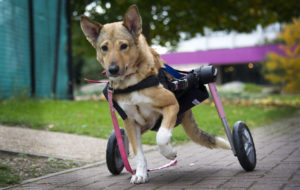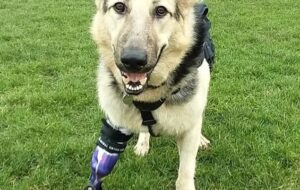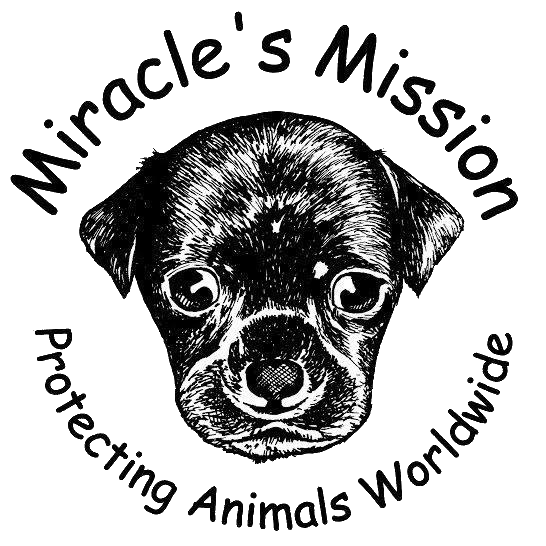Tips For Looking After Your Disabled Dog
Wheels


Wheels FAQ's
- Q: Can I leave my dog alone in the wheels? A: Dogs in wheels must be supervised at all times as while the wheels are very stable, they can tip over for example if the dog is engaging in rough play
- Q: How long can my dog be in the wheels for?A: Your dog will not be able to lay down and rest in the wheels therefore we advise a maximum of 2 hours per session. When they are just getting used to the wheels / building up strength in their front legs, even 15 minutes per session can be enough. Your dog will enjoy a massage after being in the wheels as this will get rid of any knots / tension that the straps from the wheels may cause
- Q: Can my dog pee and poop in the wheels?A: Yes, your dog will pee and poop as normal in the wheels
- Q: Can my dog still use their back legs in the wheelsA: You can adjust the wheels so that your dog can use their legs if they are still able to or if they can't use their legs, they can use the stirrups. These are elasticated and encourage your pet to exercise and maintain muscle and mobility.
- Q: Are there any limitations for my dog when using the wheels?A: This depends on your dog’s general health and injury / disability. Some dogs will need to build up strength and stamina. For a fit and healthy dog do not underestimate how fast they will be able to run in the wheels. Your dog will manage much easier on flatter walks rather than hills that put too much strain onto their front legs.
- Q: How quickly will my dog get used to the wheels?A: The wheelchairs come with guidance on how to best allow your dog to get used to the wheels. Initially let them get used to the look of the wheelchair, then the feel of the harness. Put them in it for a few moments on and reward them for being good. Treats will help as well as lots of fuss. Try and make sure only good things happen while they are in the wheels. Encourage them to take one or two steps and again use lots of praise. A very gentle push may help. Once moving, lots of praise and they’ll soon be leaving you behind. Never rush things or allow your dog to become distressed.
- Q: Can my dog play with other dogs while in the wheels?A: Yes absolutely. We encourage your dog to live a normal life as possible. Your dog will be able to run around with other dogs, chase a ball, all the other normal things that dogs do. Remember, your dog does not think of him / herself as having a disability, to them they are just getting on with life and having a good time
- Q: Is there any other advice you would give for a dog in wheels?A: When out on a walk we advise to always take water with you. While the wheels are lightweight for your dog to pull, it is still extra strain for your dog and they may get hotter more quickly than a dog out of wheels so regular water breaks are highly adviseable
Prosthetics and 3 Legs


Prosthetic and 3 Legs FAQ's
- Q: Can I leave my dog alone in the prosthetic? A: Dogs in prosthetics should be supervised at all times as while the prosthetics are very stable, the dog could chew them off or if you haven't quite fitted them properly they may come slack
- Q: How long can my dog be in the prosthetic for?A: Your dog will be able to lay down and rest in the prosthetic therefore time length of wear can be built up over the first 2 weeks. We advise a maximum of 30 minutes for the first day, a maximum of one hour for day 2 and then building up by half an hour extra each day afterwards. When they are just getting used to the prosthetic / building up strength in their leg, even 15 minutes per session can be enough to begin with. Your dog can be left in the prosthetic through the day when fully used to it but it should be taken off at night. Lots of dogs do best with not wearing it around the house and just wearing it for outdoor walks.
- Q: My dog can walk well on 3 legs but is eligible for a prosthetic leg. Do they really need one? A: Yes. We highly recommend wherever possible to use a prosthetic leg. This will drastically minimise later life joint problems and make life for your dog much more comfortable
- Q: Are there any limitations for my dog when using the prosthetic?A: This depends on your dog’s general health and. Some dogs will need to build up strength and stamina. For a fit and healthy dog do not underestimate how fast they will be able to run in the prosthetic. Your dog will manage much easier on flatter walks rather than hills.
- Q: How quickly will my dog get used to the prosthetic?A: The prosthetics come with guidance on how to best allow your dog to get used to them. Initially let them get used to the look of the leg, then the feel of it. Teach your dog that it is not a toy to be chewed or played with. Put them in it for a few moments and reward them for being good. Treats will help as well as lots of positive fuss. Try and make sure only good things happen while they are in the prosthetic to start with. Encourage them to take one or two steps and again use lots of praise. Once moving, lots of praise and they’ll soon be leaving you behind. Never rush things or allow your dog to become distressed.
- Q: Can my dog play with other dogs while in the prosthetic?A: Yes absolutely. We encourage your dog to live a normal life as possible. Your dog will be able to run around with other dogs, chase a ball, all the other normal things that dogs do. Remember, your dog does not think of him / herself as having a disability, to them they are just getting on with life and having a good time
- Q: Is there any other advice you would give for a dog in a prosthetic? A: It is extremely important that your dogs stump is checked thoroughly after each use for signs of redness, irritation or skin damage, especially during the 2 week break in period. If this happens please do not continue to use the leg and contact the manufacturer as adjustments may be needed. The leg itself should also be regularly checked for damage both interior and exterior. The interior foam can be 'refluffed' by use of a hairdryer if needed (never use a high heat).
- Q: What hygiene factors need to be considered?A: Any skin that is in contact with the prosthetic should be kept as clean as possible. The prosthetic should be cleaned after each use with a baby wipe or warm water. Any grit or dirt inside the prosthetic could seriously damage your dogs skin.
- Q: Does my dog need to wear the sock that comes with the prosthetic?A: We advise that the sock be worn yes as this adds additional comfort and an additional barrier for extra skin protection. The sock should be washed after each use. Additional socks can be purchased with the leg to save you having to wash the sock every day. The sock should be fully pulled up with no creases in it.
- Q: Are there any exercises that could help build up muscle in my dog's remaining legsA: We advise that you consult your vet and be referred to a professional physiotherapist as every dog is different however these videos may help to give you an idea of some of the possible strengthening exercises that may be advised for your dog: 1. Rhythmical stabilisations - https://youtu.be/Z52x-LYbqek 2. 3 legged stand exercises - https://youtu.be/e-Ip9m2PQFY 3. Passive range of motion exercises https://youtu.be/PYuB9_pGrhM
Incontinence
If your dog is incontinent this does not mean that the dog has to have a poorer quality of life, it is simply about managing the incontinence and getting a system organised for yourself and your dog. Some handy tips to help you are:
- Don't feed your dog late at night to minimise the chance of them going to the toilet over night
- Natural supplements such as cranberry or D-Mannose may assist vet recommended medication - please consult with your vet
- Bladder expression is extremely important if your dog needs help to pee. This needs to be done morning, afternoon and night so 3 times a day as a minimum. This is where you will gently but firmly squeeze your dogs bladder to help your dog pee.
- Incontinent dogs can often leak between bladder expressions so do be prepared to clean up more regularly than you would after a non incontinent dog however the bladder expression will limit the amount of leakage.
- We recommend that your dog does not wear a nappy unless necessary. The nappies are great for if you for example visit a friends house for a few hours but if left on long term all the time it can cause skin rashes and soreness and the build up of bacteria in the nappy can also contribute to urine infections. Therefore at least when outdoors and over night we do not recommend use of nappies. If using nappies we very highly recommend Glenndarcy Nappies (https://www.nappypantsfordogs.com) as they are extremely high quality, reusable, easy to wash, come with extra waterproof pads if needed, comfortable, soft and as an added bonus they are very stylish!
- We highly recommend the use of Vetbed and a waterproof mattress cover for your dog. We use cot size mattress covers allowing your dog to have the usual comfy bed but with the waterproof covering that you can take off and wash, leaving the bed underneath dry. We recommend the vet bed to be used on top of the mattress cover and blanket as if the dog pees onto this it soaks through onto the mattress cover leaving the top completely dry for the dog. IT is also very comfortable and easily washable in the washing machine.
- Have 2 beds for your dog so that if they do toilet over night they have a fresh bed to move into
- If you are using baby wipes to clean your dog make sure to use pet friendly wipes that are also fragrance and chemical free
- Only use non bio washing powder / liquid for your dogs bedding / nappies
- Wash your dogs bedding / nappies at 60% to kill any bacteria that may otherwise end up contributing to a urine infection
- Many incontinent dogs eating regular dog food will have diarrhea which is distressing for the dog as they like to be clean, harder for you to clean up and the bacteria can also contribute to urine infections therefore we always advise a plant based hypoallergenic food. A complete dog food in biscuit form rather than wet food is best but if your dog wants the wet food, just mix a very small amount in
- A paralysed dog will have poorer circulation in their back end. Stroking from head to tip of the tail will help their circulation
Other General Tips
- If your dog is on medication, give the medication at the same time each day
- The best type of bed for your dogs joints is an orthopaedic memory foam bed
- Please be extremely careful with your dogs if you are out on ice or on slippery surfaces
- If your dog drags his / her legs behind them or to the side, watch that they don't get stuck on doorways - if possible keep the inner doors of your home where the dog will be open fully for easy access for your dog
- Even if your dog is paralysed for the rest of his / her life, physio is still very important to help posture and blood flow. Correct the position of your dogs legs whenever possible and try to strengthen their legs with physio / hydrotherapy
- Do not over feed your dog. An overweight disabled dog will be in discomfort as it will be harder for them to move around. If you can't resist multiple treat giving throughout the day feed your dog a very small breakfast and tea and space their food out as treats throughout the day
- Having 2 water bowls is very useful. One on the ground by their bed so that they don't have to get up and down for a drink and one raised bowl for when they are already up and about so that they don't have to lower themselves down to the ground for a drink
- Lots of dogs that can't use their back legs do not like their front legs being lifted up. Thuis can be very distressing for them as they may feel like they have no balance or it could also be uncomfortable for them. For these dogs we recommend coats / harnesses than fold around the dog rather than where their front legs need to be lifted in
- If your dog can't use their back legs, one thing they will miss is being able to scratch their necks / behind their ears. If you do this for them they will love you for it!
- Joint aid supplements like glucosamine, tumeric and CBD oil are highly recommended. These can make a huge difference to your pets joints. We also recommend CBD oil (vet approved brand https://www.ellevancesciences.com)
- If you have stairs, baby gate them. Disabled dogs can be extremely good at climbing up stairs and falling down them
- Watch your dog around steps as they will try to climb them and could hurt themselves
- If your dog is cold, this can reduce the blood circulation on their back end therefore make sure to regularly check that your dog is not too cold
- Disabled dogs, particularly those in wheels and incontinent dogs can become very needy and attached and very quickly as they learn that you are doing a lot for them. Try to get your dog into a routine where you are leaving them at certain times of the day from the very start. It is good for them to mix with other people as well.
Tips for settling in
Adopting a new family member is a very exciting time but please remember that your new dog / cat may not be as excited as you are at first. They may be nervous and wondering where they are / what is happening. They need space and time to adjust to their new surroundings and experiences.
Make sure that you have planned properly how your new pet is going to fit in with your lifestyle / how you are going to adapt your lifestyle to fit to your new pet, not only right now but also in future in terms of family, travel home and work.
Ensure that your pet has a collar on at all times with an ID tag. This is a legal requirement in the UK. The collar must be properly fitting, not too loose and not too tight.
A harness for walks will stop the pull on your pets neck. Harnesses are also much more secure than collars. Make sure that your harness is double strapped underneath for extra security.
Make sure that your dog has plenty of stimulation and enrichment available in the forms of play time, walks, trips out and toys. Please be careful to supervise any toy time with toys that may be chewed up and swallowed by your pet.
